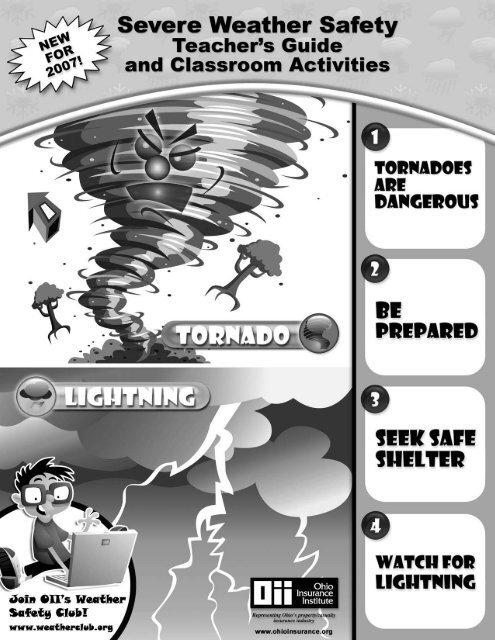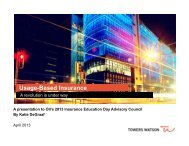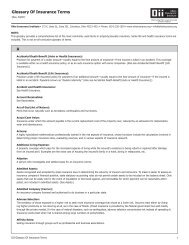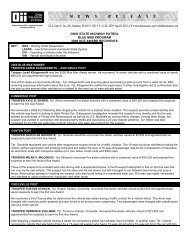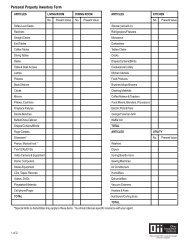Untitled - Ohio Insurance Institute
Untitled - Ohio Insurance Institute
Untitled - Ohio Insurance Institute
Create successful ePaper yourself
Turn your PDF publications into a flip-book with our unique Google optimized e-Paper software.
Tornadoes<br />
are dangerous<br />
A tornado’s strength is hard to imagine, but it can spin at speeds exceeding<br />
200 mph as it moves across land. Never try to outrun a tornado,<br />
since it can change direction in an instant. The best thing to do if a<br />
tornado is sighted is to seek safe shelter immediately.<br />
l HOW TORNADOES ARE FORMED<br />
Tornadoes form when cold, dry air meets with warm, moist air. A whirlwind<br />
is created by the gust of warm air rising in a spiral motion, causing<br />
water vapor to be swept upward. As the warm air cools, a twisting,<br />
spiral-shaped cloud forms. This funnel cloud is what we know as a<br />
tornado.<br />
Cold air whirls around the outside of the funnel, causing a roar that<br />
often sounds like a loud freight train. Air pressure inside the tornado is<br />
very low, as if there is a hole in the air. Outside, air spins into the hole<br />
carrying with it anything in its path. The tornado travels as it spins.<br />
A tornado usually lasts only minutes. Thunderstorms create the<br />
energy that feeds tornadoes. As the rain accompanying a tornado falls<br />
to earth, it cools the land. The tornado weakens as the steady supply of<br />
warm, moist, rising air dies out. The spinning motion slows down as the<br />
heated air is no longer pushed up, and is replaced by the cooler, heavier<br />
inflowing air.<br />
<strong>Ohio</strong> averages 16 tornadoes and five tornado-related fatalities each<br />
year.<br />
l TORNADO FACTS<br />
• <strong>Ohio</strong>’s tornado activity has been below average for the past few<br />
years. Four tornadoes were reported in 2005, causing no injuries or<br />
deaths. <strong>Ohio</strong>’s eight tornadoes in 2004 caused one injury and no<br />
deaths; while 12 tornadoes resulted in 18 injuries in 2003. <strong>Ohio</strong>’s<br />
tornado activity in 2002 was above average—22 tornadoes resulted<br />
in 16 injuries and five deaths. <strong>Ohio</strong>’s worst year for tornadoes was<br />
1992 when 60 tornadoes were confirmed. Texas holds the record for<br />
the greatest number—178 tornadoes occurred in the Lone Star state<br />
in 2004.<br />
NOTE: (Additional tornado statistics can be found online at www.<br />
weathersafety.ohio.gov.)<br />
• Tornadoes are usually accompanied by hail, severe thunderstorms<br />
and wind. <strong>Ohio</strong> experiences thunderstorm activity an average of<br />
30–50 days annually.<br />
• Severe Weather Awareness Week in <strong>Ohio</strong> is held annually, usually<br />
in March, to serve as a reminder to “brush up” on safety precautions<br />
prior to the height of severe weather season.<br />
• Most tornadoes occur during spring and summer months in the late<br />
afternoon on a hot day. Nationally, the peak months tend to be May,<br />
June and July. About one in every four tornadoes occurs between<br />
4–6 p.m. Peak season in <strong>Ohio</strong> is April through mid-July, with most<br />
occurring between 2–10 p.m. But, tornadoes can strike anywhere, at<br />
anytime of day or night. <strong>Ohio</strong> experienced damage-causing tornadoes<br />
in November 2002 and 2003.<br />
• A “waterspout” is a tornado over the water. Tornadoes are also<br />
known as cyclones, twisters and funnel clouds.<br />
• Over the 10-year period, 1996–2005, the US averaged 1,278 tornadoes<br />
and 58 tornado-related deaths per year. In the prior 10 years<br />
(1986–1995), the US averaged 1,003 tornadoes and 42 deaths per<br />
year. A record-breaker occurred in 2004 when 1,819 tornadoes<br />
touched down in the US, which caused 36 deaths.<br />
l POINTS TO COVER<br />
• How a tornado is formed<br />
• Why a tornado is dangerous<br />
• When <strong>Ohio</strong> tornadoes usually occur<br />
• The purpose of Severe Weather Awareness Week<br />
l ACTIVITIES<br />
1. Obtain two-2 liter pop bottles. Fill one with water. Connect the tops<br />
of the bottles, using a washer and duct tape, or purchase a “Tornado<br />
Tube” from a science or teacher supply store or online. Tip the full<br />
bottle upside down and swirl the water to drain into the empty<br />
bottle. The result depicts how a tornado forms.<br />
2. Fill a mayonnaise or mason jar with water. Make the water swirl by<br />
stirring it with a spoon. Drop in a few drops of food coloring or ink.<br />
Another way to make a tornado in a bottle is to mix water, food<br />
coloring and a few drops of liquid soap in a quart jar. Tightly cap the<br />
jar. Give the jar a quick twist with both hands and watch the vortex<br />
appear in the jar.<br />
3. To depict a tornado’s force: Get a potato and a plastic drinking straw.<br />
Hold the straw against the potato, and apply pressure (more than<br />
likely the straw will bend and not penetrate the potato). Now, hold<br />
the potato in one hand, and the straw in the other about 2 feet apart.<br />
Thrust the straw into the potato (it should penetrate depicting the<br />
force of wind). The greater the velocity of matter, the greater its momentum.<br />
The faster you make the straw move, the greater its force<br />
when it strikes the potato and the deeper it will penetrate. The force<br />
of a tornado has been known to drive straws right through boards!<br />
4. Additional activity resources<br />
• Scholastic http://teacher.scholastic.com/activities/wwatch/<br />
tornadoes/experiments.htm<br />
• Weather Wiz Kids (includes other types of weather experiments<br />
too) http://www.weatherwizkids.com/WxExperiments.htm<br />
• National Geographic Kids http://www.nationalgeographic.com/<br />
ngkids/trythis/trythis_water/bottled-vortex.html<br />
• <strong>Ohio</strong> EMA Disaster Detectives http://www.ema.ohio.gov/kids_<br />
page/index.htm<br />
be prepared<br />
It’s important that students know the difference between a tornado<br />
“watch” and “warning.”<br />
• A Tornado WATCH means a tornado could occur—the climatic conditions<br />
are right for a tornado. When a watch is issued, be prepared<br />
to seek shelter and stay tuned to the radio or television for weather<br />
updates. Or, listen to the National Weather Service updates on a<br />
weather radio.<br />
• A Tornado WARNING is your signal to SEEK SHELTER IMMEDIATELY<br />
—this means a tornado has been sighted in the area. The National<br />
Weather Service, which tracks storms on radar, will issue a tornado<br />
WATCH or WARNING as needed. Whenever there is danger of a tornado,<br />
it’s very important that you are prepared to act quickly. Some<br />
communities have special sirens to warn of an approaching tornado.<br />
Radio and television stations will broadcast information about severe<br />
weather through special weather bulletins and newscasts.<br />
Encourage your students to participate in the <strong>Ohio</strong> Committee for Severe Weather Awareness Annual Poster Contest<br />
Download details & entry requirements at www.weathersafety.ohio.gov<br />
2
l SEVERE WEATHER SAFETY KIT<br />
Every home should prepare a severe weather safety kit in case a disaster<br />
strikes. Items to include are a battery-operated transistor radio, flashlight,<br />
candles, matches, extra batteries, and a set of house and car keys. Learn<br />
about kit preparation online at these links:<br />
• <strong>Ohio</strong> Committee for Severe Weather Awareness<br />
http://www.weathersafety.ohio.gov/homekit.aspx<br />
• FEMA for Kids Create an Emergency Supply Kit<br />
http://www.ready.gov/kids/step1/index.html<br />
• <strong>Ohio</strong> EMA Kid’s Kit: What to Pack in Case of a Disaster<br />
http://www.ema.ohio.gov/kids_page/html/kit.htm<br />
• Weather Wiz Kids Disaster Supply Kit Word Search<br />
http://www.weatherwizkids.com/wordsearch1.htm<br />
• Weather Channel Family Supply Kit Word Search<br />
http://www.weatherclassroom.com/resources/safeside/SS_WordSearch.<br />
pdf<br />
l POINTS TO COVER<br />
• The difference between a tornado WATCH and WARNING<br />
• How to keep posted on current weather conditions<br />
• What to include in a severe weather safety kit<br />
l ACTIVITIES<br />
1. Have students explain the difference between WATCH and WARNING<br />
with family members.<br />
2. Have students prepare a severe weather safety kit at home or in the<br />
classroom.<br />
3. Listen to the weather band station on a radio to obtain an idea of how<br />
weather reports are issued. Or watch one of the cable weather channels<br />
for weather information when a storm is in the forecast.<br />
4. Invite a local meteorologist to your classroom to explain how tornadoes<br />
are sighted and tracked on Doppler radar. Or, plan a trip to a TV<br />
station to watch a meteorologist at work.<br />
5. Have students check Web sites of local TV stations. Some have<br />
“weather school programs” or weather-related educational links.<br />
6. Visit weather-related Web sites to gather weather information and<br />
participate in a variety of online educational activities. There are hundreds<br />
of tornado sites including:<br />
l ONLINE WEATHER RESOURCES<br />
• www.weathersafety.ohio.gov<br />
<strong>Ohio</strong> Committee for Severe Weather Awareness—Site contains<br />
resource materials for educators, consumers and reporters about<br />
severe weather in <strong>Ohio</strong>. Downloadable winter and spring safety<br />
awareness campaign materials are provided.<br />
• www.ema.ohio.gov/kids_page/html/jigsaw.htm<br />
<strong>Ohio</strong>’s Emergency Management Agency provides a special “EMA<br />
Kids Site” that offers fun and games, cool links and info for teachers.<br />
• www.ema.ohio.gov/PDFs/Severe_Weather/Owlie_Skywarn.pdf<br />
Download Owlie Skywarn’s weather book for information on what<br />
to do should tornadoes, lightning, flash floods or winter storms<br />
threaten.<br />
• www.tornadoproject.com/<br />
The Tornado Project Online—This company researches, compiles<br />
and provides tornado information with a twist including tornado<br />
myths and oddities, personal experiences, tornado chasing and<br />
safety issues.<br />
• www.fema.gov/kids/<br />
FEMA’s Area for Kids—Kids learn about tornadoes, earthquakes and<br />
other feats of nature. Links take you to such features as creating<br />
a “virtual” emergency supply kit, educational comic strips, crosswords,<br />
free supplies and much more.<br />
• www.weatherclassroom.com/login.php?vtype=teachers&url=http<br />
%3A%2F%2Fwww.weatherclassroom.com%2Fhome_teachers.php<br />
This Weather Channel link provides weather info, games and activities<br />
for teachers. Registration is required.<br />
• www.weatherclassroom.com/home_students.php<br />
This Weather Channel link provides weather info, games and activities<br />
geared toward kids.<br />
• www.spc.noaa.gov/<br />
Storm Prediction Center—SPC monitors and forecasts tornadoes,<br />
thunderstorms and other weather phenomena across the US 24/7.<br />
• www.fema.gov/kids/v_lib.htm<br />
FEMA for Kids library provides free video clips on all types of disaster<br />
preparation geared toward kids.<br />
• www.stormvideo.com/tornado/index.html<br />
View tornado footage from a variety of sources online from Storm<br />
Video.<br />
seek safe shelter<br />
Whether practicing a tornado drill or seeking shelter during a warning,<br />
the <strong>Ohio</strong> Committee for Severe Weather Awareness (OCSWA) encourages<br />
all to DUCK:<br />
D — Go DOWN to the lowest level<br />
U — Get UNDER something sturdy<br />
C — COVER your head<br />
K — KEEP in shelter until the storm has passed<br />
Some places are safer than others when a<br />
tornado hits an area. If possible, take a flashlight<br />
and a battery-operated radio with you when seeking safety. Be sure to<br />
memorize these safe locations ahead of time, so you’re not caught “off<br />
guard” if a tornado strikes.<br />
The best defense when severe weather threatens is preparedness.<br />
Every household, school and business should have an emergency preparedness<br />
plan. OCSWA offers the following tips for inclement weather:<br />
1. Hold a family meeting. Discuss tornadoes and other types of natural<br />
disasters that are common to your area. Develop evacuation and<br />
safety plans to address them. Don’t forget to include pets.<br />
2. Develop a family escape/shelter plan. Sketch an overhead view of<br />
your house. Determine two escape routes from every room if possible.<br />
Teach kids how to open windows and screens. Remember to select an<br />
outside meeting place (large tree or neighbor’s yard, etc.) in case of an<br />
emergency. Determine where to shelter during a tornado.<br />
3. Practice the plan. Conduct tornado drills so everyone is prepared.<br />
4. Organize your disaster preparedness kit. Info on the Severe<br />
Weather Safety Kit can be found at top of this page.<br />
• IN HOMES AND OTHER SMALL BUILDINGS<br />
Go to the lowest level and get as close to the center of the building<br />
as possible. A basement is best. If none exists, seek shelter in a windowless<br />
closet, bathroom or inside hall. Stay away from windows,<br />
doors and exterior walls.<br />
• IN SCHOOL<br />
Listen to your teacher. Go to an inside wall on the lowest floor.<br />
Kneel on the floor facing the wall with your hands covering your<br />
head and neck. Avoid places like auditoriums, gymnasiums or other<br />
areas with large roofs that could collapse.<br />
• IN CARS OR MOBILE/MANUFACTURED HOMES<br />
GET OUT! If possible, take shelter in a building. If not an option, lie<br />
flat in a ditch or low spot, covering your head and the back of your<br />
neck with your hands.<br />
3
• IN MALLS OR LARGE BUILDINGS<br />
Many large public buildings will have designated shelter areas.<br />
Become familiar with signs posted in these buildings. If you can’t<br />
locate the designated area, go to a middle hallway on the lowest<br />
level.<br />
• IF OUTSIDE<br />
If you can’t reach a shelter or building, lie flat in a ditch or low area,<br />
covering your head and the back of your neck with your hands.<br />
Stay clear of tall trees and open water.<br />
l POINTS TO COVER<br />
• The proper position to assume for protection<br />
• Where to go when a tornado strikes at home, outside, in a car, school<br />
or other building<br />
• Emergency preparedness plans<br />
l ACTIVITIES<br />
1. Have students act out a home tornado drill skit. Action may be different<br />
depending on type of residence (home with/without basement,<br />
apartment, mobile/manufactured home, etc.).<br />
2. Make sure all students participate in a tornado drill.<br />
3. Have students practice the proper position to assume during a tornado<br />
at school.<br />
4. Have students write a report that outlines where they would go if a<br />
tornado warning was issued while home.<br />
5. Have students develop a basic home emergency preparedness plan.<br />
Suggest they share the plans during a family meeting (www.weather<br />
safety.ohio.gov/disasterplan.aspx).<br />
watch for<br />
lightning<br />
When a tornado strikes, severe lightning will often be present. Many<br />
times the threat lightning poses is overlooked. According to the National<br />
Weather Service, over the past 30 years lightning caused about<br />
67 deaths and 300 injuries in the US each year—more than the average<br />
number of deaths attributed to tornadoes or hurricanes.<br />
l LIGHTNING FACTS<br />
• The frequency of lightning strikes varies by region. In the northwest<br />
area of the US, there are areas with fewer than five thunderstorms a<br />
year, while areas of central Florida experience close to 90. <strong>Ohio</strong> averages<br />
between 30–50 thunderstorm days a year.<br />
• Structures located on high terrain, such as mountain ranges, or buildings<br />
that are substantially higher than those adjacent to them are<br />
at a higher risk of lightning strikes. Structures adjacent to water also<br />
have a higher susceptibility rate, since water serves as a conductor.<br />
• A typical thunderstorm is 15 miles in diameter and lasts an average of<br />
30 minutes. Nearly 1,800 occur at any moment around the world—<br />
that’s 16 million a year!<br />
• Of the estimated 100,000 that occur in the US annually, about 10%<br />
are classified as severe. The National Weather Service considers a<br />
thunderstorm severe if it produces hail at least 3/4 inch in diameter<br />
and/or includes damaging winds clocked at 58 mph or higher.<br />
• According to the Lightning Protection <strong>Institute</strong>, roofs and projections,<br />
such as chimneys and steeples are most frequently hit by<br />
lightning strikes.<br />
l WHAT CAUSES LIGHTNING?<br />
The action of rising and descending air within a thunderstorm separates<br />
positive and negative charges. Lightning results from the buildup<br />
and discharge of electrical energy between positively and negatively<br />
charged areas.<br />
l OTHER ONLINE LIGHTNING RESOURCES<br />
• www.lightningsafety.noaa.gov<br />
Check the NOAA Lightning Safety Team site for handouts, indoor<br />
and outdoor safety tips, medical facts, history, survivor stories,<br />
photos, teacher tools and more. Lightning Safety Awareness Week<br />
is June 24–30, 2007. Additional NOAA site info on lightning is available<br />
at www.noaa.gov/lightning.html.<br />
• www.lightning.org<br />
The Lightning Protection <strong>Institute</strong> (LPI) presents information designed<br />
to provide a basic understanding of lightning, the severity<br />
of lightning strikes and lightning protection systems.<br />
• www.usatoday.com/weather/resources/basics/wlightning.htm<br />
Visit the Lightning Science and Safety section of the USA Today site<br />
for info on lightning basics, different forms of lightning, lightning<br />
rods, research and much more.<br />
• www.science.howstuffworks.com/lightning.htm<br />
This site explains how lightning works along with links to related<br />
info.<br />
l LIGHTNING SAFETY TIPS<br />
1. Outdoor Tips<br />
• Avoid water, especially swimming pools, and metal objects such<br />
as electrical wires, fences, golf clubs, machinery, power tools and<br />
railroad tracks.<br />
• Unsafe places during lightning include tents, golf carts, small<br />
open-sided shelters and under isolated trees.<br />
• Avoid wide open spaces and high terrain such as hilltops.<br />
• When possible, get to a building or fully enclosed shelter like a car<br />
or truck and close the windows.<br />
• If lightning strikes are nearby, avoid direct contact with others;<br />
remove metal objects from your pockets and crouch low to the<br />
ground on the balls of your feet, place hands on your knees with<br />
your head between them.<br />
• If you’re in the woods, take shelter under the lowest tree or under<br />
a bush.<br />
2. Indoor Tips<br />
• Avoid contact with water including showers, baths or laundry. Stay<br />
away from open doors and windows.<br />
• Don’t use corded or cordless phones or headsets during lightning<br />
storms because a strike could send shocks through the electric or<br />
phone line. A cell phone is the safest mode of communication during<br />
thunderstorms.<br />
• As an extra precaution unplug computers, stereos, power tools,<br />
TVs and DVDs, and other unnecessary appliances.<br />
• Stay inside until the storm subsides.<br />
3. First Aid for Lightning Victims<br />
• Call 911 immediately.<br />
• A person struck by lightning may be burned, but does not carry an<br />
electrical charge. So begin first aid procedures immediately.<br />
• If the victim is not breathing but has a pulse, administer mouth-tomouth<br />
resuscitation. If there’s no pulse, begin CPR.<br />
l POINTS TO COVER<br />
• Where to go in case of lightning<br />
• What to avoid in case of lightning<br />
• Types of materials that attract lightning<br />
• General lightning safety tips (available at www.weathersafety.ohio.<br />
gov/thunderstormslightning.aspx)<br />
4
l ACTIVITIES<br />
1. Have students discuss dangerous home locations during severe lightning<br />
(bath/shower, using the phone, using electrical appliances, etc.).<br />
2. Plan a field trip to a science/technology exhibit center like the Center<br />
of Science and Industry in Columbus (614-228-2674) or Toledo (419-<br />
244-2674). Or invite a local television meteorologist to visit your class.<br />
3. Visit the National Severe Storms Laboratory on the Web for useful<br />
lightning research and reference information at www.nssl.noaa.<br />
gov/edu/.<br />
4. Learn CPR—contact local American Red Cross chapters and fire departments<br />
to determine if they offer Cardiopulmonary Resuscitation<br />
classes.<br />
5. Lightning and related experiments online:<br />
www.weatherwizkids.com/lightning.htm<br />
www.eo.ucar.edu/webweather/forecasttips.html<br />
http://weathereye.kgan.com/cadet/lightning/experiment.html<br />
6. Research the invention and uses of lightning rods.<br />
Source: Portions excerpted from Tornadoes, written by Ann Armbruster and<br />
Elizabeth A. Taylor, 1989.<br />
Questions? Contact <strong>Ohio</strong> <strong>Insurance</strong> <strong>Institute</strong>, 172 E. State St., Ste.<br />
201, Columbus, OH 43215-4321, 614-228-1593 •<br />
www.ohioinsurance.org • e-mail: info@ohioinsurance.org •<br />
Download OII’s Severe<br />
Weather Safety color<br />
sheet and crossword<br />
challenge at<br />
www.ohioinsurance.org/<br />
pdf/SevereWeather<br />
Coloring.pdf<br />
ANSWER KEY:<br />
TORNADO<br />
CROSSWORD<br />
CHALLENGE<br />
ANSWER KEY:<br />
TORNADO<br />
WORDSEARCH<br />
PUZZLER<br />
4<br />
4<br />
<br />
<br />
<br />
<br />
<br />
<br />
<br />
<br />
<br />
<br />
<br />
<br />
<br />
<br />
<br />
<br />
<br />
<br />
<br />
<br />
<br />
<br />
<br />
<br />
<br />
<br />
<br />
<br />
<br />
<br />
<br />
<br />
<br />
<br />
<br />
<br />
<br />
<br />
<br />
<br />
<br />
<br />
<br />
<br />
<br />
<br />
<br />
<br />
<br />
<br />
<br />
<br />
<br />
<br />
<br />
<br />
<br />
<br />
<br />
<br />
<br />
<br />
<br />
<br />
<br />
<br />
<br />
<br />
<br />
<br />
<br />
<br />
<br />
<br />
<br />
<br />
<br />
<br />
<br />
<br />
<br />
<br />
<br />
<br />
Join OII’s Weather<br />
Safety Club!<br />
www.weatherclub.org<br />
A TORNADO STRIKES<br />
3 p.m. 5 p.m.<br />
1. Tornadoes can occur at<br />
any time, but they favor<br />
the warmest part of the<br />
day, when thunderstorms<br />
are strongest.<br />
2. A TORNADO WATCH has<br />
been in effect since 3 p.m.<br />
THE VAN WERT TORNADO<br />
NOVEMBER 10, 2002<br />
IND.<br />
N<br />
INDIANA<br />
PAULDING<br />
COUNTY<br />
OHIO<br />
Scott<br />
Cavett<br />
Tornado moved<br />
southwest to<br />
northeast<br />
224<br />
Wren<br />
3<br />
MILES<br />
Detail area<br />
Fort<br />
Wayne<br />
Toledo<br />
Columbus<br />
OHIO<br />
Paulding<br />
Melrose<br />
Tornado path<br />
VAN WERT<br />
COUNTY<br />
Van Wert<br />
127<br />
3. A funnel cloud is sighted<br />
but doesn’t touch the<br />
ground. Funnel clouds<br />
often appear white<br />
against a dark sky.<br />
Sometimes funnel clouds<br />
will disappear without<br />
touching the ground.<br />
4. A TORNADO WARNING is<br />
issued.<br />
This November storm spawned several tornadoes in <strong>Ohio</strong> killing five<br />
and injuring 26. At least four tornadoes with winds exceeding 100<br />
mph were reported in Van Wert County. The National Weather Service<br />
tracked a tornado through Twinsburg, Macedonia and Solon.<br />
Another twister hit Ashland and Medina counties, and yet another<br />
touched down in Wayne County.<br />
According to a survey by the <strong>Ohio</strong> <strong>Insurance</strong> <strong>Institute</strong>, losses<br />
from this storm exceeded $103 million, making it one of the costliest<br />
<strong>Ohio</strong> natural disasters in recent history.<br />
Grover Hill<br />
30<br />
Delphos<br />
Defiance<br />
Ayersville<br />
Continental<br />
Oakwood<br />
224<br />
15<br />
PUTNAM<br />
COUNTY<br />
Holgate<br />
108<br />
Ottawa<br />
Lima 75<br />
TOM BAKER | DISPATCH<br />
Source: Graphic used with permission from Columbus Dispatch, November 12,<br />
2002<br />
5<br />
100–<br />
SPIRALING W
AVERAGE PATH LENGTH IS 6 TO 9 MILES<br />
5:04 p.m. 5:09 p.m. 5:12 p.m. 5:15 p.m.<br />
1000 FEET<br />
DEBRIS CLOUD<br />
100–250 MPH<br />
SPIRALING WINDS 30–40 MPH<br />
AVERAGE WIDTH IS 420 FEET<br />
5. A funnel cloud touches<br />
the ground and becomes<br />
a tornado.<br />
6. The winds pick up dirt and<br />
debris from the ground.<br />
7. Path of damage is at its<br />
widest.<br />
8. The tornado is vertical and<br />
moves from the southwest<br />
to the northeast at 35<br />
mph.<br />
9. Funnel darkens with<br />
debris.<br />
10. The funnel narrows and<br />
tilts away from its vertical<br />
position.<br />
11. The path of damage<br />
becomes smaller.<br />
12. The funnel weakens into<br />
a rope-like shape then<br />
disappears. The average<br />
duration of a tornado is 15<br />
minutes.<br />
This is how the weather map looked as the worst of the<br />
tornado outbreak was descending on the <strong>Ohio</strong> Valley.<br />
Cold, dry air<br />
4:50 p.m.<br />
19 killed in Monticello, Ind.<br />
Cool, humid air<br />
BETWEEN 3 AND 5 P.M. APRIL 3, 1974<br />
XENIA-OHIO’S WORST DISASTER<br />
A “superoutbreak”<br />
Sometimes tornadoes occur in multiple outbreaks. On April 3 and<br />
4, 1974, tornadoes swarmed in greater numbers and across a wider<br />
area than anytime in recent history. Some were among the strongest<br />
ever recorded.<br />
The tornadoes began in Indiana around 9:30 a.m. April 3. The last<br />
tornado struck North Carolina 24 hours later. The hardest hit town<br />
was Xenia, <strong>Ohio</strong>. The Arrowhead neighborhood was devastated.<br />
Dry air<br />
Storm<br />
center<br />
over<br />
Iowa<br />
3:40 p.m.<br />
35 killed in<br />
Columbus<br />
Warm front has<br />
cleared central<br />
<strong>Ohio</strong><br />
Xenia, <strong>Ohio</strong><br />
4:10 p.m.<br />
31 killed in Brandenburg, Ky.<br />
The two-day toll<br />
• 148 tornadoes struck 11 states from Michigan to Alabama.<br />
• 315 people were killed and about 5,000 were injured. More than<br />
27,590 families suffered some kind of loss.<br />
• Total damage exceeded $600 million.<br />
• The weather system produced at least six violent tornadoes,<br />
including the one at Xenia. That’s about as many as are normally<br />
recorded in a decade.<br />
Warm, humid air<br />
Cold<br />
front<br />
advancing<br />
eastward<br />
Source: Portions excerpted from Columbus Dispatch, March 20, 1996<br />
Not all tornadoes are funnel-shaped.<br />
The Xenia tornado was a half-mile<br />
wide, whirling dark cloud. Top winds<br />
were estimated at 250 mph. The path<br />
of damage was as wide as eight football<br />
fields.<br />
Feb. 2007<br />
6


